#Sika deer adaptations
Text
🦌🎶 The Voice of Nara: Exploring the Unique Sika Deer Sounds🎶🦌
🦌 Step into the enchanting world of Nara, Japan, where ancient culture meets the mesmerizing language of Sika deer. 🇯🇵🌸...
🔍 The Whistle of Caution 🔔 As the sun casts a warm glow over Nara Park, the Nara deer's keen sense of alertness is evident in their gentle whistles. 🌞🔉...
😊 The Snort of Curiosity 😄 One of the highlights of visiting Nara is the heartwarming interaction with the friendly Sika deer! 🥰🦌...
🎶 The Whistle of the Rut 🦌🍁 As autumn arrives, Nara Park witnesses a captivating transformation within its deer community. The rutting season begins, and the park comes alive with melodious whistles of the male Sika deer! 🍂🍃...
Don't miss this incredible journey through the captivating language of the Sika deer! 🦌🗣️...
Check out my blog for more information about Nara and the Deers!
#Sika deer#Nara#Japan#Nara Park#Deer vocalizations#Whistling deer#Deer sounds#Rutting season#Wildlife in Nara#Nara deer experience#Sika deer behavior#Deer courtship calls#Wildlife encounters#Sika deer adaptations#Deer communication#Red deer bugle calls#White-tailed deer vocalizations#Fallow deer barks#Moose grunts#Deer species diversity#Keystone species#Nature's language#Wildlife symphony
6 notes
·
View notes
Text
Chapter 13 Trivia
Extremely rare no-abs shirtless male character from Dr. Stone. Keep this picture safe, it's the only one of its kind…
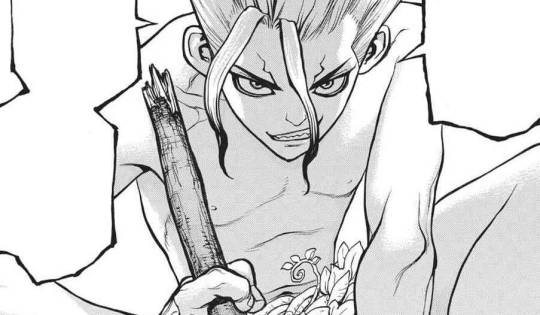
This is the same location as Taiju passed through on his journey, but taken from an angle slightly further back. Some parts look a little different, but the same broken statues are present.
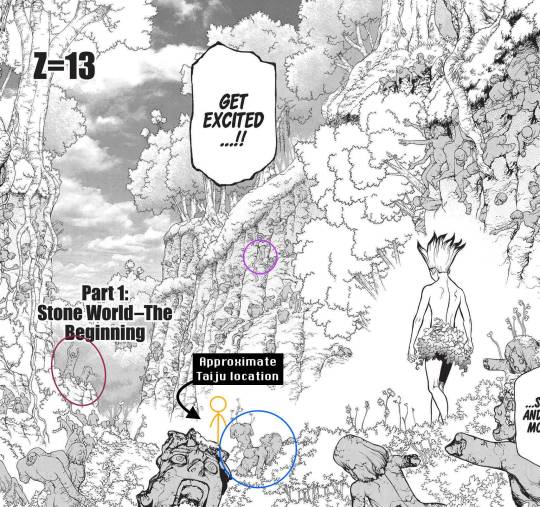
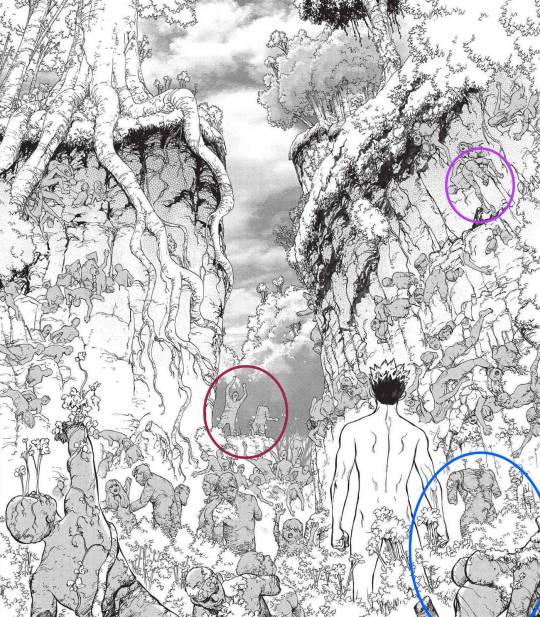
The monkeys that follow Senku around are Japanese macaques, which are a species of Old World monkey present across most of Japan. They are also the most northern-living primate (not counting humans), and as such are adapted to the colder Japanese climate in the year 5738.

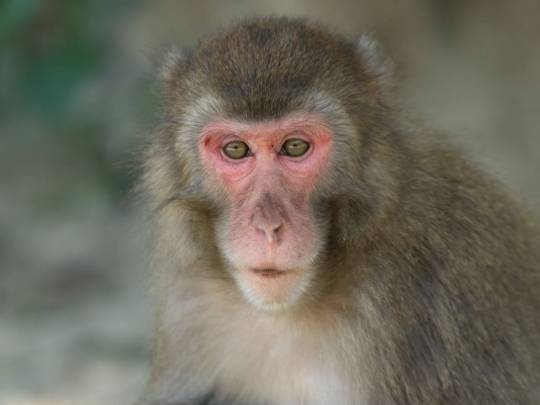

Senku couldn't start a fire with this setup, but neither would Taiju or Yuzuriha. The wood is wrong: the bottom should be stable like a plank, with a divot and a notch in it for catching the embers. The drill part should be much thinner, without bark, and rounded at the end.
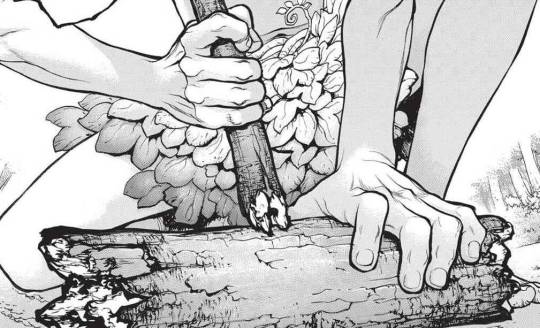
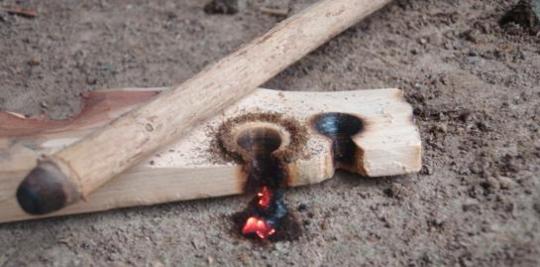
Chert is a 7 on the Mohs scale, so it's hard, but not "off the charts".
Senku uses two percussion techniques to shape the stone: hard-hammer and bipolar. The former is used more frequently as it is more precise, but the latter is used when the stone isn't good quality.
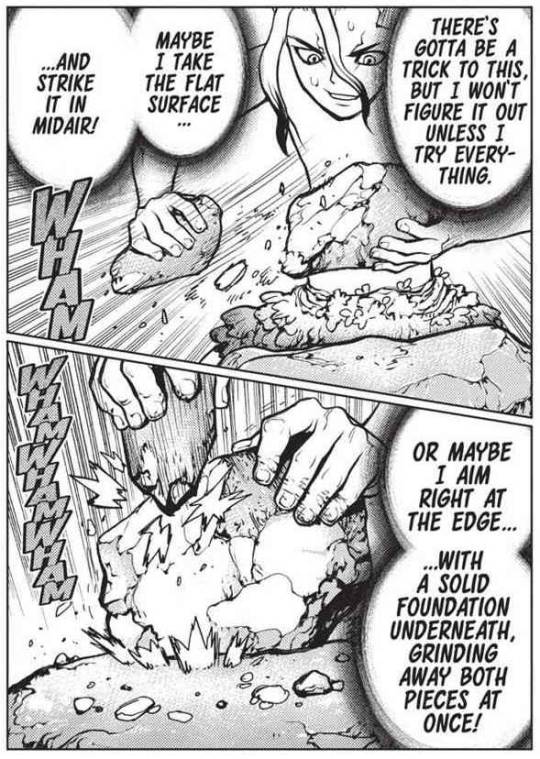
After the rough shaping, Senku grinds the stone to have a polished edge, which makes it more durable. Polishing flint/chert is one of the markers of the transition from the Mesolithic to Neolithic Stone Age, as polished axes were more efficient at clearing trees for farmland.
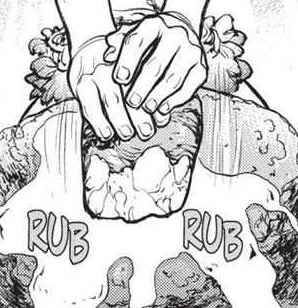
I spent some time testing how to make plant cord, and Senku's methods are correct. Scraping away at the plant removes the bark and non-fiber-y parts leaving the long strings behind. Flax, hemp, and nettles are good plant choices, as they have longer fibers for twisting.
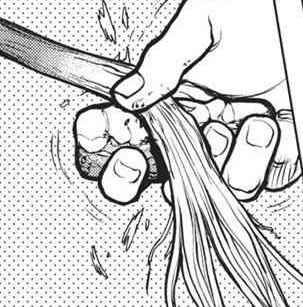
Senku's rope looks like 1-ply, meaning only a single strand is being twisted. This seems to contradict his earlier hand motions, as twisting parts in both hands would result in 2-ply, but his inexperience may be the reason it didn't work correctly. More plys means stronger rope.
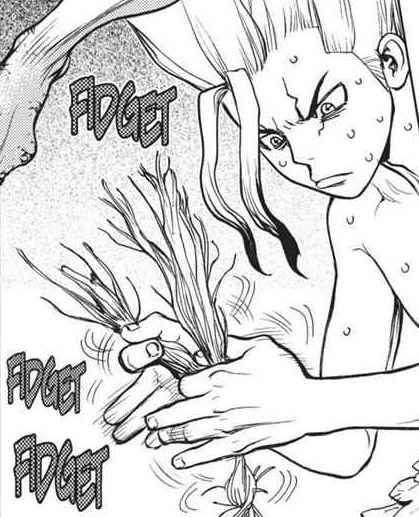
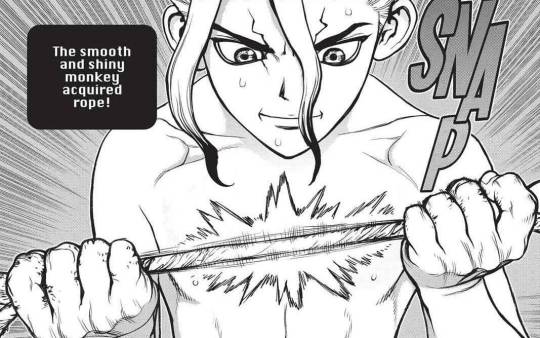

Rubbing sticks raises the heat of the wood through friction, but the goal is to get the wood hot enough to decompose into what's known as pyrolysis products. Those products burn in oxygen, which then raises the heat more and creates a chain reaction, setting the wood on fire.

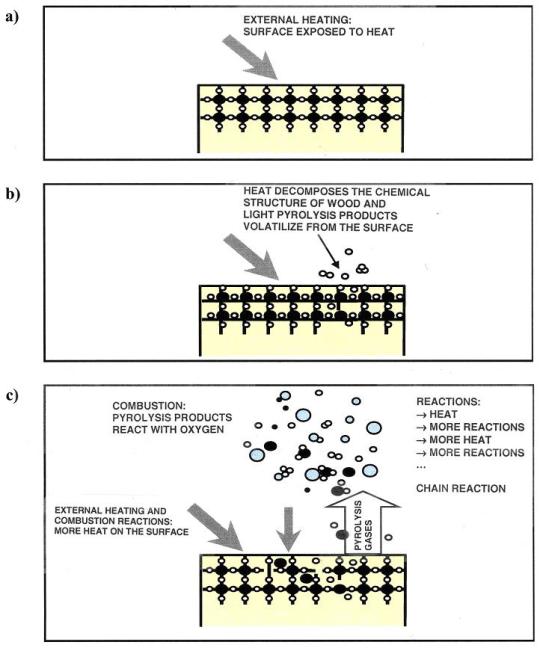
Assuming this deer is an adult Japanese sika deer, it weighs around 40-70kg. Senku at this point probably weighs under 61kg. In order to confidently lift a deer, Senku needs to have a counterweight of at least 70kg.

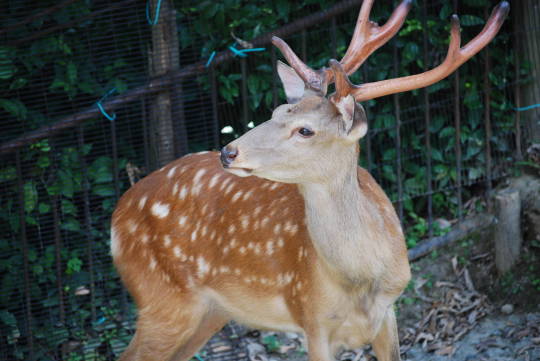
In this case, he bends a small tree using his own weight (one handed, even), but the chance of this tree being that elastic and capable of lifting over 60kg without simply breaking is almost impossible.
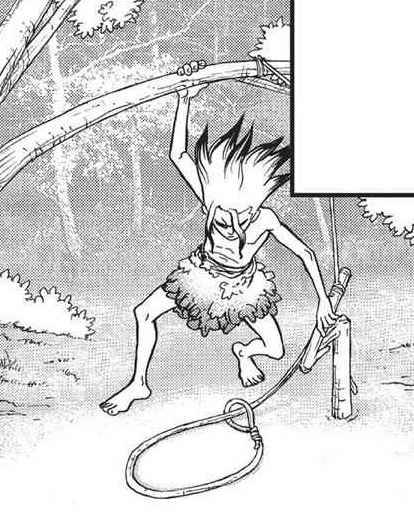
The more realistic option would have been using a counterweight such as a large log or stone, so that when the trap is activated, the counterweight falls and the trapped animal goes up.
However, that requires Senku to be able to lift something that heavy above his head.

Making leather requires several steps that can take several weeks to several months to complete. The hides need to be scraped and soaked in special solutions, have tannins added, and other processes.
The gnawing Senku is doing happens after the tanning, and is used to soften the leather. The modern way to do it is to rub it across a smooth/rounded surface, such as a sawhorse or metal pipe. The bending will make it more supple and won't destroy your jaw.
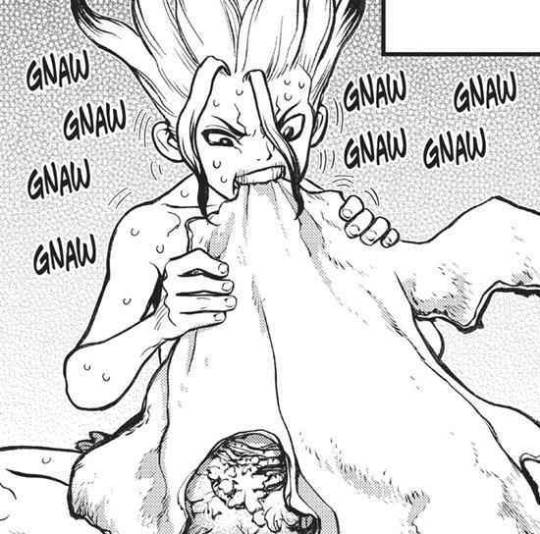
We see that one of the snow monkeys has a baby on their back. Snow monkey babies are normally born from April to June. Four months after birth, the babies are too big to hang from their mother's underside, so they move to her back.
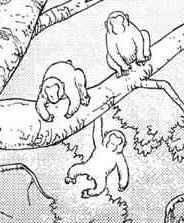
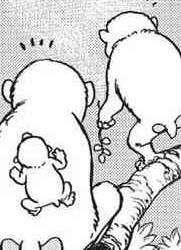
The earliest this time scene could be is therefore August, which is about 2 months before Taiju depetrified. Any of Senku's experiments or builds likely happened in those last 2 months, since we don't see him progress with anything else before then.
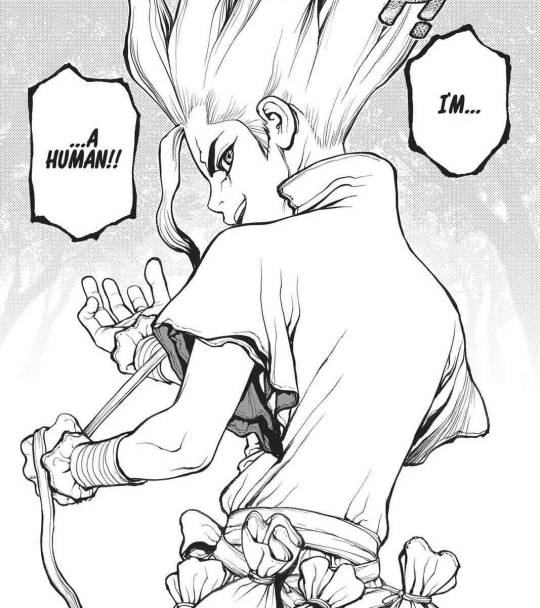
I know this chapter took a while, but the topics were too interesting and also testable so I went a little overboard with how hard I was looking things up haha!
29 notes
·
View notes
Text
Barghest (Canis lupus barghest) – Coward Pack
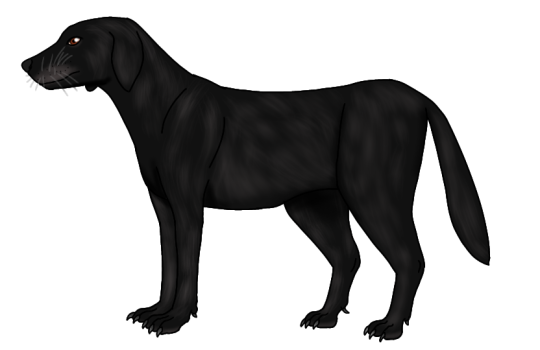
Barghest is one of mythical creatures introduced in Earth Responsibly universe.
Physiology
Barghest is a large wild dog that resembles Labrador retriever, except for larger than pet dog and heavier, darker, and scarier than average dogs, blackish gray sharp claws, jet black fur, long bushy tail, and red ringed iris.
Abilities
Barghest is stronger than ordinary dog, and their fangs are smaller serrated, which is lack their own saw-line tooth of their ancestor. This tooth that cause bleeding that doesn't heal anymore. Live in the pack led by alpha male, this species is less larger than dog due to island gigantism such as in United Kingdom or Britain, the archipelago in Europe.
Barghest triggers the ability to dash itself at the back of enemy, will be bite or kicked like a horse. Also, the Barghest is balanced animal, which is crossed on electric wires or zipline wires.
Behavior
Despite being gruesome, this species was neutral and docile to humans, even if attacked, they we ran away and some of those are fight back. If the Barghest is in pack, the group ran away and constantly being coward. The Barghest and the dog cannot fight each other, and only main enemy of Barghest, the invasive species of deer: muntjac, sika deer, and fallow deer for control of native roe deer and red deer in Britain and Scotland.
Distribution and Habitat
Barghest was well adapted canine in all biomes, but it was native in United Kingdom as endemic species.
Lore
Origins of this species was truly controversial, the descendants of feral dogs during Neolithic period once the land bridge between France and Britain disappear. The land bridge collapse after the sea level rise and become English Channel. One of black dogs become Barghest and evolved into larger and more intelligent than dogs in Britain before Roman Empire to Victorian era.
Barghest means "mountain ghost" in Germanic languages, including the English language, due to being adapted in all areas and including mountainous terrain. Barghest is afraid of Shug Monkey, the dog-like macaque found in Britain, Wales, and Scotland.
#barghest#ognimdo2002#earth responsibly#science fantasy#earth#art#fairytale#earthresponsibly#future#speculative evolution#ibispaint art#art ph#canine#dog#canidae#black dog#black wolf#animal#mythical creatures
0 notes
Text
Facts About Fallow Deer: Diet, Habitat & Pictures

Fallow deer are a species of deer native to Europe and Asia, with the Persian fallow being the most common. These majestic animals are known for their distinctive winter coat, which varies in color from white to dark brown.
During the rutting season, males will establish a rutting stand and compete for females within their small herd. Fawns are born in late spring or early summer and stay with their mother until they are old enough to join the herd. Fallow deer are adaptable and can be found in a variety of habitats, including open fields and wooded areas.
The History of Fallow Deer

Fallow deer have been introduced to many parts of the world as game animals, including North America, Australia, New Zealand, and South Africa. In some areas, such as Australia, they have become an invasive species due to their ability to adapt to new environments and reproduce quickly.
Fallow deer were first introduced to Britain by the Romans over 2,000 years ago as a source of food and sport. Today there are several populations of wild fallow deer living throughout Britain.
Why Are Fallow Deer Invasive?
Fallow deer can quickly become an invasive species because they have no natural predators in many parts of the world where they have been introduced. This allows them to reproduce rapidly and outcompete native species for resources such as food and shelter.
When Was Fallow Deer Introduced To Britain?
Fallow deer were first introduced to Britain by the Romans over 2,000 years ago as a source of food and sport. Since then, several other introductions have occurred from different regions across Europe.
Why Was The European Fallow Deer Introduced To Australia?
The European fallow deer was first introduced into Australia in the mid-1800s for hunting purposes. They were brought over from England on ships along with other game animals such as red deer and sika.
Feeding Habits of Fallow Deer
Fallow deer are herbivores and feed on a variety of vegetation including grasses, leaves, buds, and bark. They are known to be selective feeders and will choose the most nutritious parts of plants to eat.
Physical Characteristics of Fallow Deer
Fallow deer are one of the most recognizable deer species due to their unique physical characteristics. They have a lean body with long legs, allowing them to run at high speeds. Fallow deer are known for their distinctive appearance, with a white-spotted coat and large body size. Their footprints are also easily identifiable in soft soil or snow, as they have heart-shaped prints.
The average size of an adult fallow deer is around 3-4 feet tall at the shoulder and can weigh up to 200 pounds. Male fallow deer typically have antlers that measure around 23-27 inches in length, while female fallow deer do not have antlers. Measuring antlers is an important aspect of tracking the growth and health of male fallow deer populations.
Aside from their physical attributes, fallow deer are also known for their adaptability to different environments. They can thrive in various habitats such as forests, grasslands, and even urban areas. This adaptability has led to successful introductions of fallow deer populations in many countries worldwide.
Habitat and Diet of Fallow Deer

Fallow deer are known to be adaptable creatures, thriving in various habitats such as woodlands, grasslands, and farmlands. Their diet consists of a variety of vegetation that includes leaves, shoots, fruits, and nuts. These selective feeders change their diets depending on the season and availability of food.
The habitat of fallow deer is diverse. They can be found in different parts of the world like Europe, Asia Minor, North Africa, and New Zealand. In Europe alone, they inhabit 35 countries and have been introduced to other continents for hunting purposes. Fallow deer prefer open spaces with some trees or bushes for cover. During the winter months when food is scarce or covered by snowfall, they move to lower elevations where there is more vegetation available.
Fallow deer's diet varies throughout the year as it changes according to seasonal availability. During spring and summer months when there is plenty of vegetation growth, they feed on fresh grasses and herbs. In autumn when fruits begin to ripen on trees like apples and pears or nuts such as acorns become abundant on oak trees; fallow deer will eat them too! As winter approaches with its harsh weather conditions limiting food sources significantly - fallow deer will switch their diet from fresh greens towards woody plants' bark.
Fallow deer's selective feeding habits allow them to survive in areas where other herbivores may not thrive due to competition for resources. They can also adapt their diets based on what types of plants are available in different regions around the world.
Mating System and Reproduction of Fallow Deer
Fallow deer have a unique and intriguing mating system that involves competition, aggression, and group dynamics. During the breeding season, also known as the rutting period, male fallow deer compete for access to females in a polygynous mating system. This means that dominant males mate with multiple females while other males are left without a mate.
The rutting period occurs from October to November in temperate regions. During this time, dominant males exhibit aggressive behavior towards other males and attract females through vocalizations and displays. These displays can include roaring, parallel walks, and neck wrestling.
Females form groups during the breeding season which can range from small groups of 2-3 individuals to larger groups of up to 30 individuals. Group size and composition can affect mating success and may also impact the ecology of the surrounding habitat. For example, large groups of female fallow deer may cause damage to crops or vegetation.
Interestingly, research has shown that male fallow deer are more successful in attracting mates when they are surrounded by larger groups of females. This suggests that female group dynamics play an important role in determining mating success.
In addition to competition for mates, male fallow deer also face challenges such as predation and habitat loss which can impact their reproductive success. Understanding the intricacies of fallow deer's mating system is crucial for conservation efforts aimed at protecting these fascinating animals.
Life Cycle of Fallow Deer

Fallow deer have a life expectancy of up to 16 years in the wild. These beautiful creatures are known for their distinctive palmate antlers and spotted fur. They are herbivores, feeding on grasses, leaves, and shoots.
Fawns are born in late May or early June after a gestation period of 230 days. Fawns are born with white spots that disappear after three to four months. During this time, they stay close to their mothers and nurse frequently.
Male fallow deer reach sexual maturity at around 18 months, while females reach it at around 16 months. Once they reach maturity, males will compete for mates during the breeding season in October and November. This is when male deer shed their antlers and grow new ones in preparation for the next breeding season.
Fallow Deer Facts: Fun Facts for Kids
Fallow deer are fascinating animals that have captured the attention of many due to their unique characteristics. Here are some fun facts about these majestic creatures that you might not know.
-
Adult fallow deer can weigh up to 200 pounds.
Fallow deer are among the largest species of deer, and adult males (bucks) can weigh up to 200 pounds. Females (does) are typically smaller and lighter, weighing between 70-110 pounds.
-
Fallow deer have been introduced to many parts of the world, including North America and Australia.
Originally from Europe and Asia, fallow deer have been introduced to many other parts of the world as game animals or for ornamental purposes. They have become established in places like North America, Australia, New Zealand, and South Africa.
-
The number of antlers on a fallow deer can indicate its age and health.
Male fallow deer grow antlers each year that they use for fighting during mating season. The number of points on their antlers can indicate their age and overall health. Bucks with more points are typically older and stronger than those with fewer points.
-
These deer are social animals and often live in herds.
Fallow deer are social creatures that often live in herds consisting of females and their young. Males typically live alone or in small groups outside of mating season but will join the herd during the breeding season.
-
Fallow deer are known for their beautiful spotted coats.
One of the most distinctive features of fallow deer is their spotted coat. The spots range from white to black depending on the subspecies, but all have a reddish-brown base color. This coloring helps them blend into their forested habitats.
Native Populations of Fallow Deer

Fallow deer are one of the most unique and fascinating species in the family Cervidae. They are native to Europe and Asia but have been introduced to many other parts of the world, including North America, South America, Australia, and New Zealand. In this section, we will explore some interesting facts about fallow deer populations.
British deer populations include fallow deer, sika deer, and several other deer species. Fallow deer have palmate antlers that are shed annually and can be used to determine the age of a deer. The antlers grow back each year with more branches as the animal ages. This makes it easy for hunters to identify mature males from young ones.
Fallow deer are typically found in mixed woodland and forests where they form herds and feed on vegetation. These herds can range from a few individuals to several hundred animals depending on the habitat's carrying capacity. Historical herd sizes were much larger before human settlement reduced their numbers drastically.
The natural history of fallow deer is fascinating because they exhibit both migratory and sedentary behavior patterns depending on their location. For example, some populations migrate seasonally between high-altitude summer ranges and low-altitude winter ranges while others remain sedentary throughout the year.
Global Distribution and Conservation Status of Fallow Deer
Fallow deer are a globally distributed species, with populations found in various areas of the world. Their conservation status is considered "least concern" on the IUCN Red List due to their widespread range.
One area where fallow deer are particularly abundant is the UK, where they are considered a common species. However, despite their wide distribution and relatively stable population numbers, there are still some concerns about their conservation status.
Conservation efforts for fallow deer have been focused on protecting their habitats and managing populations through hunting and other means. In some areas, such as New Zealand, fallow deer have become an invasive species that can cause damage to local ecosystems.
Despite these challenges, fallow deer remain an important part of many ecosystems around the world. They provide food and other resources for humans and other animals alike, and their presence helps to maintain healthy ecosystems.
How High Can Fallow Deer Jump?
Fallow deer are known for their impressive jumping abilities. Research shows that they can jump up to 7 feet high, which is higher than the average height of an adult human. This ability allows them to escape predators and navigate through their natural habitats with ease. Additionally, fallow deer are agile and quick on their feet, making them excellent runners as well. Their powerful legs and muscular bodies make them well-suited for jumping and running, making them a fascinating species to observe in the wild.
Are Fallow Deer Dangerous?
Fallow deer are generally not considered dangerous to humans. They are known to be timid and will usually flee when they sense danger or feel threatened. However, it is important to remember that they are still wild animals and should be treated with caution and respect. If approached too closely or cornered, a fallow deer may become aggressive and use its antlers to defend itself. It is also important to avoid feeding or approaching them as this can lead to habituation and potentially dangerous situations in the future.
All About Fallow Deer
Fallow deer are fascinating creatures that have captured the attention of many wildlife enthusiasts. Their physical characteristics, habitat, and mating system make them unique among other species. With a global distribution and conservation status in mind, it's important to understand their life cycle and native populations.
Whether you're a kid looking for fun facts or an adult interested in their E-E-A-T value, fallow deer are worth learning about. From their majestic antlers to their social behavior, these animals continue to intrigue us with their beauty and complexity. So next time you spot a fallow deer in the wild or at a zoo, take a moment to appreciate all that they represent in the animal kingdom.
- Eastern Roe Deer – Beautiful and Wild Siberian Roe Deer
- Meet the Roe Deer of New Forest
- Referans: FALLOW DEER FACT SHEET
- Conservation and management of fallow deer (Dama dama dama L.)on Lemnos Island, Greece
Read the full article
0 notes
Text
It turns out if you sort Chihaya, Taichi, Arata, and Shinobu into the Mahoutokoro houses, they end up into separate houses
• House Seiran: Taichi
Color: slate gray
Animal: Sika deer
Attributes: bold, imaginative,
prudent, intuitive
- inner strength and keen intuition
- follow their quests to the end
- tight-knit and fiercely protective
• House Yosamu: Arata
Color: midnight blue
Animal: kite
Attributes: patient, idealistic,
adaptable, protective
- knows the value of truth even when it leads to another's demise
- easily pieces clues together
- seek out the positive in their situation
• House Toppu: Shinobu
Color: sea green
Animal: eel
Attributes: meticulous, quick-witted
perceiving, appreciative
- often seen as carefree and blithe
- mindful of details around them
- meticulous on their efforts and focused on creating their best possible work
- angry at themselves for miniscule errors
- easily makes friends but has no qualms in cutting ties with those they distrust
• House Shunrai: Chihaya
Color: dusty lavander
Animal: cat
Attributes: confident, unpredictable
good-humored, inquisitive
- curious and confident minds
- test their boundaries and seek limits that have never been explicitly stated
- creative and thirsty for knowledge
- first to ask why and last to clarify their findings
Though I'm not so sure if I'm being accurate, so if anyone wants to disagree, it's cool.
#sorry im still thinking about this#chihayafuru#chihayafuru mahoutokoro#chihaya ayase#taichi mashima#arata wataya#shinobu wakamiya
7 notes
·
View notes
Text
since i’m busy atm, here’s the current concepts of my toontown ocs so far with nhung being the only one with a name so far LMAO under the cut!
as their designs are planned to be human ocs for an original story about vietnamese-american espers i have, it’s likely there’ll be this running motif that the “good guys” are more likely to be girls w vietnamese names while the “bad guys” are more likely to be boys w white/western names too atm
Toons
🎲 (Toontown Central): Nhung runs Jest for Laughs down at Loopy Lane, but messes around and plays tricks on everyone more often; she has great pride in her skills like taking risks in any situation, which help earn a lot of jellybeans and notoriety for her. While she has intentions to keep things happy around Toontown, they’re more out of self-interest with just causing mischief for the fun of it.
Her design is based on the dice game bầu cua tôm cá, the spotted sika deer in the game (not to mention antler velvet is a thing in traditional medicine), and red velvet cake. Specializes in throw and/or drop gags, taking a gamble with their accuracy rates for strong attacks like her dice rolls.
🌊 (Donald’s Dock): A Toon who spends her time swimming and fishing among the currents of Donald’s Dock, she has practically become one with the water itself, adaptable to gracefully flow along with any situation to sweeping into thunderous, freezing fury when necessary. Ironically, she can seem very rigid and nervous when she’s out of her comfort zone (both metaphorically and literally) experiencing something new like a fish out of water.
Her design would either be based on Vietnamese water puppetry, beautiful fashion like this dress based on the Trần dynasty, and/or sailors and fishermen. Specializes in squirt gags as she thrives in sources of water and practically has hydrokinesis.
💐 (Daisy Gardens): A hardworking gardener cultivating plants around Toontown, she enjoys growing various plants to help the world’s atmosphere and anyone in need of some organic gags or fruits to have enough energy for the day. While she does sell her grown products to everyone, she always maintains affordable prices with the main goal to fairly distribute and trade stuff (she has to use the same jellybeans she earns to plant for her gardening after all gdjhfdj)!
Her design would be based on agricultural aspects of Vietnam, such as farming attire, traditional flowers and fruits, etc. Specializes in toon-up gags as her green thumb has helped flowers, organic gag trees, and Toons flourish alike.
🎵 (Minnie’s Melodyland): A prodigy in the musical arts, this Toon is invested in honing her skills to conduct and play songs powerful enough to bring forth any emotion she wishes. While she likes using her instruments to revive the Laff in fellow Toons with her gardening friend, she also has a hidden side of screaming ear-wrenching nightmares to make cogs explode instantaneously.
Her design would be based on musical instruments (I’m personally debating on whether to focus on modern western instruments, traditional Vietnamese instruments, or both), along with possibly including singing like karaoke, especially as that’s an activity done with friends! Specializes in sound gags, as she’s always ready to let loose and unleash powerful death metal explosions.
⛸️ (The Brrrgh): A strong contender in the local ice skating competitions, this Toon enjoys friendly competition and motivating herself and her friends to always improve. She admires her friend from Donald’s Dock the most in particular, astounded at her graceful aquatic talents practically gliding on the water surface without the need of skates or ice at all.
Her design would be based on snowy aesthetics, and I’m thinking of leaning mostly into the ice skating side of things... Specializes in lure gags, as they’re combined with her skating to show off hypnotic performances impossible to look away from.
✒️ (Donald’s Dreamland): A fantasizing Toon who runs Visible Ink down at Loopy Lane with Nhung for fun, she spends more time at her residence in Donald’s Dreamland (day)dreaming and writing in her dream diary with the sparkling pens in her possession. Loves sleeping to the soothing songs of her musical friend, but also respects and fears her skills in playing and screaming echos that can be heard across all of Toontown.
Her design would be based on dream diaries and ink, and may include toys as well. Specializes in trap gags, as they’re scattered around like toys that haven’t been cleaned up before bedtime, along with the fact the traps are effective without alarming sound gags interrupting her slumber along with the cogs’s as well.
Cogs
📞: A Telemarketer who frequents the streets and phone lines across Toontown, he carries a self-confident attitude talking to anyone and everyone to buy/invest in whatever Totally Reliable And Actually Existing Product he’s “selling” or just listen to him in general. However, Nhung is the only one who constantly disregards and makes fun of his schpiels with a bantering attitude instead, and thus annoys him to no end.
🌱: During an invasion, this Bean Counter descended into the streets of Daisy Gardens and was caught off guard by the great amount of colors in the local flora he had never seen before in the other streets. Deciding to investigate these strange lifeforms as vibrant and energetic as the Toons, he eventually became enamored with meticulously collecting jellybeans and growing them into full-fledged plants, even having his gardening activities approved of when showing off his creations like organic money trees.
🔪: Sharpening his blades down the streets of Polar Place, this Back Stabber has an arsenal of weaponry... his most prized being a pair of ice skates. In the beginning, he initially had a piercing interest in doing his job with as much efficiency as possible, and picked up skating with the intent to increase the speed of productivity and battles against the Toons. Now he enjoys skating to his own leisure and competing in ice skating battles more these days, but would be defensive and try to claim otherwise if questioned about it.
🧀: An absolute blockhead of a cog, this Big Cheese always acts like a hotshot with his former fame being a formidable high rank among the Bossbots, all while also deliberately sidestepping armor-piercing topics like his incapability to fly with the lack of a propeller, gaping holes in his head, lacking a group attack, and being considered the weakest tier 8 cog for traits like these. Even with the days of glory behind him, he still adamantly tries to keep up with the current trend of what’s “cool”, constantly jumping the Loan Sharks.
🎭: The combined forces, or more accurately, faces, of Double Talker and Two-Face parts melded together during a low resource day in the factories, these two brothers both strive to earn great acclaim and attention to prove themselves... but the thing is, they struggle with such drastically differing personalities, desired ways to achieve their goals, and the predicament of sharing a single body. Even though they oppose each other often, they still stick together and secretly admit the concept of having their own separate body and losing their brother would feel wrong in the end.
2 notes
·
View notes
Note
hello there mr. explorer!!! i am here to ask about hunting!!! Ꮚ`ꈊ´Ꮚ what's your favorite thing about it??? how do you prefer to hunt???? and do you think adding glitter to coffee is providing a good start in the morning???? ฅ•ω•ฅ
Hey there mr. Rats! Im glad ye asked! And honestly its quite hard for me to pick just one thing that i like about hunting because there are multiple things that factor into me enjoying it!
For starters its raw! Ye know like, yer up against animals that are much more adapted to surviving in a forest than you are, from the exceptional strength of a brown beart to the incredibly quick and agile movements of a sika deer! Theyee all top o' the game ye know? We're pretty pathetic by comparison to those magestic creatures aint we? Now i do use hunting rifles sometimes when im with me bro because thats its own flavor of fun, just goin wild with yer brother, but i enjoy usin less powerful weaponry, sumn i can make from whats available in the forest ta be able ta catch up with the fauna there! Ya dont know how rewardin' it is ta bring a bear down with just a couple o' well aimed arrows, hell even better when its wither yer own two hands!
Other than that its sumn me and ma big bro have always enjoyed as kids, we did it with me dad often back when he was as headstrong as a bull bless his heart! So there are those fond memories, the men in our family have this kinda comin of age ritual where when a lad turns 12 he has ta kill a bear on his own, of course the older men train us before hand an' observe.
but ya know me first encounter with a bear was when i was 7 almost died, but a friend of mine held off the bear with 'is bare arms! The bear tore 'is forearms but he still carried me home. That was a big inspiration for me. Sumn about the courage and the heroism of that man got ta me so ya could say its admiration and a bit 'o sentimentality mixed in with how rewardin it is and haha heehee times with big bro.
And damn mr.rat! Glitter ta yer coffee? I mean i hate coffee iss as bitter as a highschool girl who was rejected by her crush that went on to date her bestfriend. But the idea sounds stellar, like the doctor who's do me autopsy would be all like blinded by the glow of my guts, what a way ta be remembered ayy? Glitter guts. Might add glitter to my tea! Good idea!
2 notes
·
View notes
Text
Why do people see the world differently?
Many people have heard that dogs are color-blind.
To be exact, dogs are daltonism.
In fact, in mammals, except for primates, all other mammals are red-green colorblindness.
The reason why the eye can see is that there are two types of cells in the eye: one is called rod cells, which have little judgment on color, but are very sensitive to light, so night vision depends on rod cells.
There is also a type of cone, which can distinguish between colors, which is judged by the fact that when one color shines on it, the electrical signal it sends to the nerve is very strong, but when the other colors are irradiated, the electrical signal is very weak.
So one of these two types of cells is responsible for identifying whether there is light, and the other is responsible for identifying the color of light.
Fortunately, of all mammals, only primates have three types of cones, while other mammals have only two.
Three kinds of human cones output the strongest electrical signals when the light wavelengths are 560nm, 530nm and 420nm, respectively, and these three colors correspond to yellow, green and blue, respectively.
Other mammals have only yellow and blue cones.
So from a human point of view, all mammals are red-green blind.
Scientists have found that the vast majority of reptiles, fish, amphibians and birds have four kinds of cones, that is, they can see much richer colors than we do, and the world is very bright in their eyes.
Is it possible that the more we primates evolve, the weaker we are?
This may be a misunderstanding of evolution by many people.
Evolution does not necessarily develop in the direction of becoming more and more complex and powerful, but in the direction of more and more adapting to the environment.
Although mammals have appeared since the Jurassic, they can only be regarded as vulnerable groups, with small size and small living space, and most of them come out to look for food at night.
Many mammals today evolved from the branch of nocturnal mammals 200 million years ago.
For nocturnal animals, distinguishing what it is far more important than distinguishing color, so tens of millions of years ago mammals had to make enough room for rods to identify black and white so that they could see more clearly at night.
After the extinction of the dinosaurs that had ruled the earth, it made room for mammals to live, and the number of the latter soared.
However, the cones remained the same because there was not enough pressure on the environment and competitive species in color discrimination, so most mammals have had yellow and blue cones ever since.
Birds differentiated from dinosaurs are not extinct, so most birds have night blindness and can't see clearly as soon as the sun goes down.
Primates, on the other hand, have sprung up, leaving behind tricolor vision during an accidental gene mutation, which can give rise to a huge advantage in the jungle, so primates retain green-sensitive cones.
However, this gene has not been around in the primate branch for a long time, only for a few million years.
If you do the statistics, you will find that about 6% of the people in the population lack green-sensitive cones, that is, they are red and green blind.
Strictly speaking, they also have green cones, but the number is much smaller than other people.
In fact, they are the ones who inherited the ancestral genes of nocturnal mammals millions of years ago.
However, because the skill advantage of being able to tell whether it is green or not is so obvious in the jungle environment, the proportion of people with three kinds of cones is actually more than 94%.
We have hardly heard of blue-yellow blindness, because all mammals have blue and yellow cones, and only a small number of people do not retain the green cones that have just been developed. so most of the color blindness we see is red-green blindness.
Knowing the knowledge of eye color discrimination and the story of the evolution of cones in mammals, we can understand another thing: why tigers, dressed in yellow and black striped fur, can hunt in temperate jungles.
I was always confused when I was a child, because even if the tigers in the jungle had stripes, the yellow and black colors were so conspicuous in the green background. How on earth did they hide themselves?
Now we know that in the eyes of sika deer, tigers and grass are dark or shallow in black and yellow, because sika deer can not see green.
In this way, the stripes on the tiger play a hidden role.
If we have a set of switches in our eyes that can turn off the neurotransmission of green cones, then the world we see when turned off and on is very different.
If birds have a high IQ, they will also realize that the world in human eyes is very boring.
There are exceptions, however. In 2012, the University of California, Irvine identified a person with four types of cone cells.
The woman's name is Concetta Antico,. Her extra cone corresponds to orange.
What does the world look like in her eyes?
None of us can describe this, but in theory, everything she sees is more yellow and red than what we normal people see.
Scientists at the University of Irving studied her gene and found that the mutated gene occurred on the X chromosome, at OPN1MW and OPN1MW2, respectively.
In this respect, women have innate advantages. They are not easy to become red-green blindness, and they are more likely to become people with four-color vision, and it is estimated that women with four-color vision account for 2% of all women.
This is by no means a small group, but it is too difficult to confirm, and very few people have been identified.
This Concetta Antico is famous because she is not only a person with four-color vision, but also an impressionist painter, so her works are not only works of art, but also have some scientific research value.
Art professionals evaluate her works as: the color is seriously purple, and purple is a more cautious color in painting.
There is a theory that some colors inhibit people's perception of other colors, such as yellow and purple.
When yellow appears, the ability of the human eye to feel purple is weaker.
The female painter can receive yellow more sensitively in her eyes, so the purple in what she sees is not enough to stimulate the brain.
She thinks that paintings with balanced colors will obviously feel purple in the eyes of people like us who are not so sensitive to yellow.
For people with four-color vision, the sensitive wavelength of their cones to light still falls in the region of visible light, and the band of visible light is 400 nm to 750 nm.
But if the sensitive band of the newly mutated cones can fall in the ultraviolet or infrared region, the world in their eyes will be completely different.
2 notes
·
View notes
Text
Amur Leopard

STATUS Critically Endangered
POPULATION More than 84 individuals
SCIENTIFIC NAME Panthera pardus orientalis
WEIGHT 70 -105 pounds
HABITATS Temperate, Broadleaf, and Mixed Forests
Website
Leopards are commonly associated with African savannas, but in the Russian Far East, an unique subspecies has adapted to living in the temperate woods that make up the species' northernmost territory. The Amur leopard, like other leopards, can reach speeds of up to 37 miles per hour. This amazing creature has been seen to leap over 19 feet horizontally and up to 10 feet vertically.
The Amur leopard lives alone. It is agile and strong, and it carries and hides unfinished kills to avoid being eaten by other predators. Some males have been known to stay with females after mating and even assist with child rearing. Several males may pursue and battle for a female. They live for 10-15 years in the wild and up to 20 years in captivity. The Far East leopard, Manchurian leopard, and Korean leopard are all names for the Amur leopard.
WHY THEY MATTER
The Amur leopard is environmentally, commercially, and culturally significant. Other species, such as Amur tigers and prey species like deer, benefit from its habitat conservation. We can bring them back and assure the region's long-term conservation with the correct conservation initiatives.
THREATS
ILLEGAL WILDLIFE TRADE
The Amur leopard is mostly hunted for its stunning spotted fur. In the Russian settlement of Barabash, not far from the Kedrovaya Pad reserve, an undercover investigation team discovered a female and a male Amur leopard skin being sold for $500 and $1,000, respectively, in 1999. The leopards' habitat is surrounded by agriculture and communities. As a result, poaching is a problem—not only for leopards, but also for essential prey species like roe deer, sika deer, and hare, which are killed by people for food and money.
PREY SCARCITY
Across the Amur in Russia and China, significant swaths of appropriate habitat remain. The prey base in China is insufficient to support substantial leopard and tiger populations. Prey populations will rebound if measures are made to reduce prey poaching and forests are managed more sustainably for logging. The Amur leopard must repopulate its old range in order to live in the long run. However, first and foremost, prey populations must rebound.
“Amur leopards are teetering on the brink of extinction. With the establishment of the Land of the Leopard National Park, in conjunction with other conservation efforts, we can now start to focus on how to begin bringing them back.”
Website
Patreon Token — Patronize of Animals and Environment
Get to know the Patreon Token
The Patreon Token is a cryptocurrency created by three pet-friendly crypto fans to create support for the animal welfare and conservation organizations they love, anytime, anywhere. The Patreon Token was created on December 01, 2021. It is made of 88 million pieces and each cryptocurrency can be divided into 8 decimal places.
Our goal
Our team will distribute a minimum of 80 million PTRN tokens to various aid organizations. This means that we want to send 8,000 tokens for free to at least 10,000 animal welfare and conservation organizations, which can be sold to generate revenue. The remaining 8 million tokens will be used to develop to our project. The most important thing for us is that all animal welfare and conservation organizations on the planet can be easily and instantly supported by everyone, wherever they live or stay in the world.
#animal#animals#animal welfare#animal protection#saveearth#savetheplanet#savetheanimals#save the environment#nature protection
1 note
·
View note
Photo




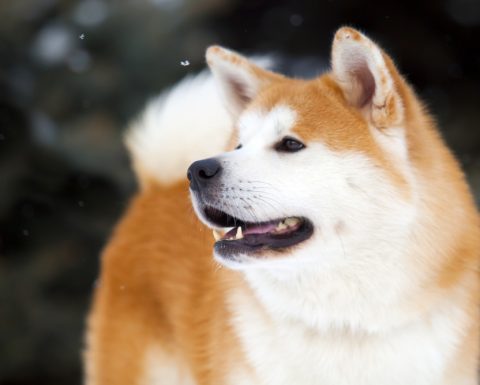
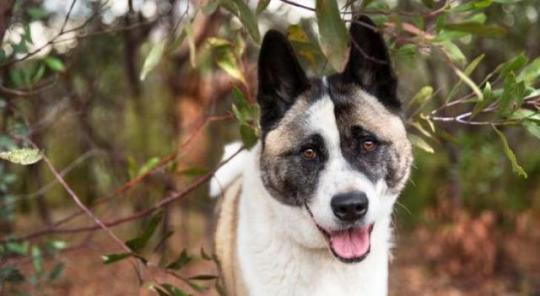
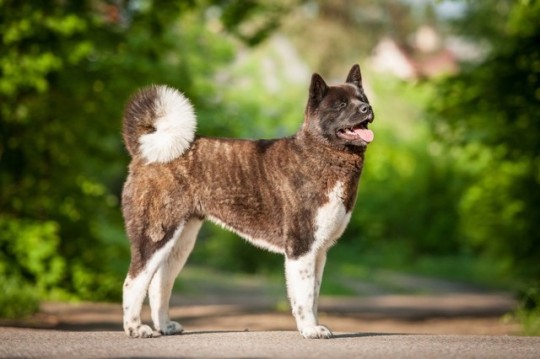
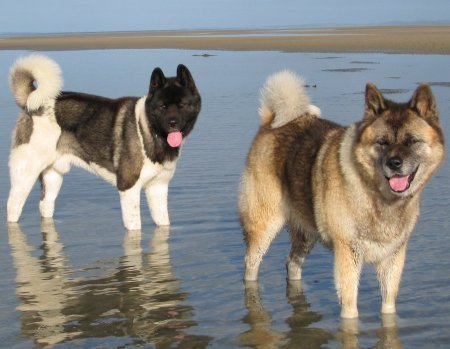

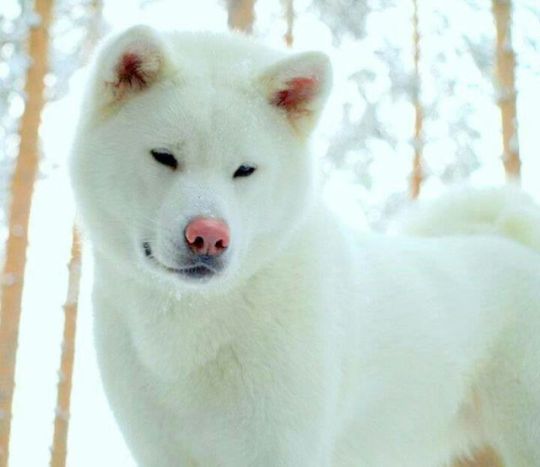
Akita
he Akita is a large breed of dog originating from the mountainous northern regions of Japan. There are two separate varieties of Akita: a Japanese strain, commonly called "Akita Ken" in Japan, "Akita Inu" ("inu" means "dog" in Japanese), or "Japanese Akita"; and an American strain, known as the "Akita" or "American Akita" The Japanese strain called the Akita Inu comes in a narrow palette of colors, with all other colors considered atypical of the breed, while the American strain known simply as the Akita comes in all dog colors.
In all countries (except the United States and Canada) the Japanese and American strains of Akita are considered two separate breeds. In the United States and Canada, however, the two strains are considered a single breed with differences in type. For a while, the American strain of Akita was known in some countries as the "Great Japanese Dog".
Japanese history, both verbal and written, describe the ancestors of the Akita, the Matagi dog (hunting dog, Bear hunting dog, Deer hunting dog), as one of the oldest of the native dogs. The Matagi's quarry included wild boar, Sika deer, and Asian black bear. This precursor dog tracked large game, holding it at bay until hunters arrived to make the kill. Today's Akita developed primarily from dogs in the northernmost region of the island of Honshū in the Akita prefecture, thus providing the breed's name. The breed is also influenced by crosses with larger breeds from Asia and Europe, including English Mastiffs, Great Danes, St. Bernards, and the Tosa Inu, in the desire to develop a fighting dog for the burgeoning dog fighting industry in Odate in the early 20th century. During World War II the Akita was also crossed with German Shepherd Dogs in an attempt to save them from the wartime government order for all non-military dogs to be culled. The ancestors of the American Akita were originally a variety of the Japanese Akita, a form that was not desired in Japan due to the markings, and which is not eligible for show competition.
The Japanese Akita and American Akita began to diverge in type during the Post–World War II era. It was during this time, that US servicemen serving as part of the occupation force in Japan first came into contact with the Akita, the breed so impressed them that many service members chose to bring an Akita back home with them upon completion of their tour. American servicemembers were typically more impressed with the larger more bear-like fighting Akita or German Shepherd type than they were with the smaller framed and fox-like Akita-Inu; the types of dogs they brought back with them to the US reflected this sentiment. Japanese Akita fanciers focused on restoring the breed as a work of Japanese art or to 'Natural Monument' status. American Akita fanciers chose to breed larger, heavier-boned and more intimidating dogs.
Although both types derive from a common ancestry, there are marked differences between the two. First, while American Akitas are acceptable in all colors, Japanese Akitas are only permitted to be red, fawn, sesame, white, or brindle. Additionally, American Akitas may be pinto and/or have black masks, unlike Japanese Akitas where it is considered a disqualification and not permitted in the breed standards. American Akitas generally are heavier boned and larger, with a more bear-like head, whereas Japanese Akitas tend to be lighter and more finely featured with a fox-like head.
As a spitz breed, the appearance of the Akita reflects cold weather adaptations essential to their original function. The Akita is a substantial breed for its height with heavy bones. Characteristic physical traits of the breed include a large, bear-like head with erect, triangular ears set at a slight angle following the arch of the neck. Additionally, the eyes of the Akita are small, dark, deeply set and triangular in shape. Akitas have thick double coats, and tight, well knuckled cat-like feet. Their tails are carried over the top of the back in a gentle or double curl down the loin
The story of Hachikō, the most revered Akita of all time, helped push the Akita into the international dog world. Hachiko was born in 1923 and owned by Professor Hidesaburō Ueno of Tokyo. Professor Ueno lived near the Shibuya Train Station in a suburb of the city and commuted to work every day on the train. Hachikō accompanied his master to and from the station each day. On May 25, 1925, when the dog was 18 months old, he waited for his master's arrival on the four o'clock train, but Professor Ueno had suffered a fatal brain haemorrhage at work. Hachikō continued to wait for his master's return. He travelled to and from the station each day for the next nine years. He allowed the professor's relatives to care for him, but he never gave up the vigil at the station for his master. His vigil became world-renowned when, in 1934, shortly before his death, a bronze statue was erected at the Shibuya train station in his honor. This statue was melted down for munitions during the war, but a new one was commissioned after the war. Each year on April 8 since 1936, Hachikō's devotion has been honoured with a solemn ceremony of remembrance at Tokyo's Shibuya railroad station
343 notes
·
View notes
Text
Modified Bitumen Membranes - APP Waterproofing Membrane
APP Waterproofing Membrane Application & Characteristics
APP uses polyester reinforcement or covering material reinforcement because the original supply, and APP, APAO, because the modifier, and covers the insulation materials as polythene, sands, or gravels. A.P.P. (Atactic plastic Plastomeric) sort changed membrane, consisting of a specially developed hydrocarbon compound of distilled asphalt changed with elite finest visco-elastic polymers and strengthened with a high-quality non-woven polyester carrier.

An APP Waterproofing Membrane is coated with either a sanded or talc high surface end, whereas a very cheap surface is adorned and guarded by a heat-sensitive polyethylene film. This kind of end for the lower surface has been chosen for 2 specific functions.
General-purpose APP waterproofing membrane designed and made for the particular desires of the roofing contractors. The plastomeric changed hydrocarbon compound (BPP) that is employed offers wonderful flexibility and workability on any roof. The carrier may be a non-woven bolstered polyester giving wonderful performance in terms of mechanical resistance. The high dimensional stability is obtained by insertion of a fiber reinforcement within the polyester itself.
Characteristics for APP waterproofing membrane Uses & Applications for APP waterproofing membrane
Fine Anti-Water Pressure And Anti-Leakage Property With Water Tightness/Impermeability Effect; sensible Tearing Resistance, Puncture Resistance, Weather-Ability, mildew Resistance, Fatigue Resistance, Aging Resistance Property; No Dripping, No Flowing underneath Hot Temperature; No Crack underneath Cold Temperature With Tight Overlaps/Edges/Ends, No Pollution/Contamination And Environmentally Friendly.
High enduringness, sensible Elongation And Self-Healing Property Adapt To The Contract/Expansion Of Substrates further because the Deformed/Cracked Substrates, SBS Membranes ar wide utilized in The Waterproof Works Of Cold Regions and therefore the Substrates that simply Deformed; Whereas APP Waterproofing Membranes ar wide utilized in The Waterproof Works Of hot temperature and powerful Sunshine Regions. Heat Melting Inhibits The operating is wiped out the complete Year, simple operating.
Uses & Applications for APP waterproofing membrane
Basement
Terraces
Podium
Underpass
Bridges & Tunnels
Roof Gardens
Underground Car Parks
Medium to large roof slabs
Satiate leads the means for specialist services and solutions for the development business. Satiate is the country’s leading supplier of innovative solutions in Passive fireplace protection, Construction chemical, Waterproofing chemicals, Grouting compound, Admixtures chemical, highest quality sealants and intensive variety of APP Waterproofing Membrane.
Satiate Solutions is a Hilti authorised Firestop Speciality Contractor & Authorised supplier of Japanese deer. Backed by our adroit team of execs, we have a tendency to area units able to give our purchasers with Associate in Nursing different gamut of APP Waterproofing Membrane accustomed forestall discharge in varied areas. Satiate Solutions leading distributors & suppliers within the field of housing industry, we have a tendency to area units engaged in giving a varied qualitative Sika® WP defend vary of APP Waterproofing Membrane to our customers.
Satiate Solutions
Contact us: (+91) 8530409518, (+91) 9960602620
Visit us: http://www.satiates.in/app-waterproofing-membrane-sika-wp-shield.php
#appwterproofingmembrane#appwterproofingmembraneinpune#appwterproofingmembraneinnashik#appwterproofingmembraneinnagpur#appwterproofingmembraneinsolapur
0 notes
Text
Endangered Animals In China
The Himalayan Brown Bear
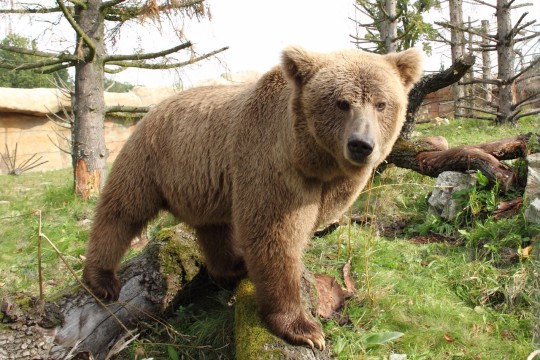
Himalayan Brown Bears (Ursus Arctos Isabellinus) are species of brown bears.
Their colours are sandy or reddish-brown.
They commonly live at the mountains of Afghanistan, Pakistan, Northern India, West China, Nepal, Kazakhstan and Tibet.
Male bears are about 4 feet and 11 inches ro 7 feet to 3 inches while female bears are 4 feet and 6 inches to 6 feet tall.
LIke regular bears, the Himalayan Brown Bears use their strong front legs for running at the speed of 35 mph and swimming. Both of the activities: running and swimming helps the bear hunt and adapt.
Unfortunately Himalayan bears are slowly decreasing or highly endangered these days. Reasons are because of habitat loss, fragmentation, poaching and bear-baiting.
Panthera Tigris
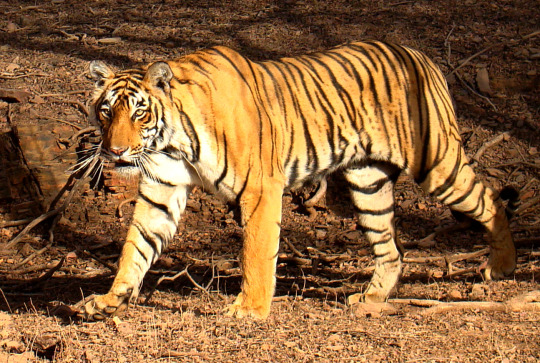
Human-caused biodiversity loss is a global problem, large carnivores are particularly threatened, and the tiger (Panthera tigris) is among the world’s most endangered large carnivores. The South China tiger (Panthera tigris amoyensis) is the most critically endangered tiger subspecies and is considered functionally extinct in the wild
The tigers live in a wide variety of habitats, suggested by their distribution across a wide range of ecological conditions. They are known to occur in tropical lowland evergreen forest, monsoonal forest, dry thorn forest, dry oak and birch woodlands, tall grass jungles, and mangrove swamps. They are able to cope up with a broad change of climatic variation, from warm moist areas, to areas of extreme snowfall.
Reintroduction is the way on how they are going to prevent the endangered species the Panthera Tigris. What is Reintroduction? Reintroduction is a potential benefit for individual species or for broader ecosystem function. Intertwined with such benefits are related motivations or outcomes that can span aesthetic, sociological, cultural, political, or economic aspects. These in turn may differ according to species, scale, and economic context.
The government of China, together with the leaders of tiger range countries, recently declared a goal to double the world’s wild tiger population by 2022. Due to the growing awareness of the importance of tiger reintroduction as one strategy to support tiger recovery goals, Chinese authorities and international organizations are seeking to identify one or more existing protected areas of sufficient size within the historical range of South China tigers to support wild tiger populations. This would be the world’s first large-scale reintroduction of captive tigers back to the wild.
A free-ranging population of 15–20 tigers living in a minimum of 1000 km2 of habitat was identified as a target. The government assessed summer and winter habitat suitability of two critical prey species, wild boar (Sus scrofa) and Sika deer (Cervus nippon), using GIS spatial models to evaluate the potential for tiger reintroduction in one likely candidate site.
They identify major challenges facing a potential tiger reintroduction project and conclude that restoring the habitat and prey base, addressing concerns of local people, and enhancing coordination across park boundaries are significant challenges to meeting the broader goals of supporting a reintroduced wild tiger population.
Habitat Regions: temperate, tropical, terrestrial.
Terrestrial Biomes: tundra, taiga, savanna or grassland, forest, rainforest, scrub forest, mountains.
Wetlands: Marsh-are wetland areas often dominated by grasses and reeds.
Ailuropoda melanoleuca
Ailuropoda melanoleuca also known as the panda bear or simply the panda, is a bear native to south central China. It is characterised by large, black patches around its eyes, over the ears, and across its round body, the giant panda is one of the most beloved animals in the world.

Furs: They were hunted for their valuable furs. Poaching has declined in recent years, due to new laws and greater public awareness of conservation efforts. Perhaps more critically, destruction of their native forests destroyed much of the bamboo pandas relied upon to survive. Pandas face a lot of dangers, but zoos and panda reserves are doing everything they can to keep them from becoming extinct.
Habitat Loss: By far, the greatest threat facing wild pandas, and the biggest reason they are critically endangered today, is deforestation on the part of humans, which has led to permanent habitat loss in some areas. Wild pandas once roamed bamboo forests in China, Vietnam, Laos and Burma. Today, wild pandas are found only in China, and in far fewer numbers than ever before. Scientists estimate that there are only around 1,800 wild pandas alive today. Habitat loss spells certain doom for pandas. If a bamboo forest is cleared away, then the pandas' food source is gone. Relocating to another forest is often impossible, as forests today have become separated from one another, thanks to human cities and towns. Without access to a steady source of bamboo, pandas whose forests are cleared will perish from starvation.
Difficulties Adapting: Some animals have found ways to adapt to human activity in areas that were once wild. For example, raccoons once lived primarily in forests but now inhabit many cities and towns, eating discarded food left behind by people. Raccoons are able to adapt in this way because of their physical attributes, such as their digestive systems, which can digest nearly any kind of food, and their small size, which allows them to hide easily. There are other animals, such as pigeons and rats, that have adapted in similar ways to live alongside humans.Pandas have no such adaptations. They cannot simply move into cities and towns when their forests are destroyed, mainly because they are so specifically adapted to a life of eating bamboo. Pandas' digestive systems can't properly digest anything else. Because bamboo shoots and leaves don't contain many nutrients, pandas also must consume vast quantities of it – around 20 to 40 pounds a day. Even if pandas could eat something other than bamboo, pandas could never blend in safely in cities or towns, due to their large size. For pandas, the environment they originally adapted to is the only environment where they can thrive.
Difficulties Reproducing: Even in captivity, breeding pandas is notoriously difficult. Pandas are extremely selective about choosing their mates, which means that even if a male and female panda are kept in the same enclosure for years, there is no guarantee the pair will mate. If pandas do mate in captivity, the cubs often need to be hand-raised by people, since captivity seems to throw off the maternal instincts of many panda mothers, causing them to abandon or even harm their cubs. Because of these issues, conservation programs that release pandas into the wild, in order to increase their numbers.
1 note
·
View note
Photo
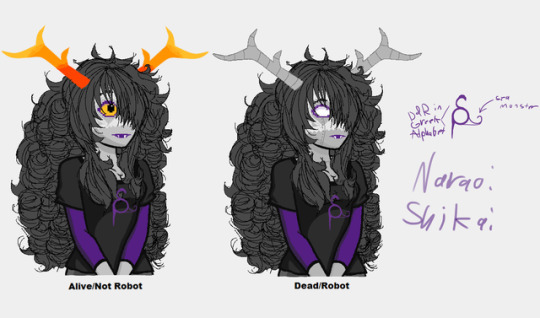
Name: Naraoi Shikai
Theme/Inspiration: Shinto and Greek deer mythology, specifically “Actaeon, after witnessing the nude figure of Artemis bathing in a pool, was transformed by Artemis into a stag that his own hounds tore to pieces.”
Blood: purple
Sign: see picture
Weapon: double scythe
Powers (optional): chucklevoodoos
BRIEF physical description: large curly hair, robot, tall, slim, blank faced
Lusus: sika deer
Height: 6’
Gender: female
Alternia/Beforus: alternian
Personality: seems bored all the time, is actually always having fun, introvert, spacy
Strengths: highblood, lazy, strong
Weaknesses: highblood, hot-headed sometimes, stonefaced, spacy, easily infuenced
Likes: peanut butter, crystals, mythology, humans, plants, space, deer mom, messaging friends, musicals, history
Dislikes: sleeping, plugs, clothes, hurting people
Backstory (optional, but it helps a lot!): When she realized she was destined to kill and be aggressive she thought “But I don’t want to be like that…” After a long time of trying to not be like that, one day out of rage from a sudden outburst she killed one of her closest friends. That wa when she decided to confront the one she trusts, a loyal indigo blood who stayed with her even after her outbursts, and she ordered her friend to kill her. After the indigo blood refused to let her leave forever and came to a compromise to become a robot. With a few modifications in her personality, she told the friend to make her become introverted and someone who hides away so she could never hurt her friends again.
Ongoing story: She lives in isolation to avoid hurting others, only communicating through messages with a select amount of friends. She is visited by some of them but she doesn’t let them stay long in fear of hurting them. These days she doesn’t do much except listen to the soundtracks of various musicals including Girl Goes to School of Bullies and Hopes For a Better Future Until She Gives The Most Popular Girls in School a Forged Hall Pass And Gets Taken Under Their Wing Till She Meets a Mysterious Boy In a Seven Eleven(…) and Troll Adaptation of Earth Founding Lusus The Musical.
Prospit/Derse: Prospit
God Tier (optional): Maid of Mind(or Rogue of Doom)
Sgrub Planet (optional): Land of Electricity and Flora
(Bonus points if you know what musicals im talking about)
~~~~~
(Sadly I don’t know the name of the musical since I basically live under a rock lmao.)
I really like the amount of thought that went into this! The whole unintentionally killing a friend is a good motive too. :)
The robot thing can go a bit far, but it fits the backstory well and I’m all for shooting for something unique, and considering the shit that happens in Homestuck it’s not too entirely far-fetched. Also, I really REALLY like the hair! It’s so fluffy and I want to hug it.
Although I do have a question. Where did you get the talksprite base? :0 I really like it and it’s very difficult to find a good one that’s made with pixels instead of a normal brush, which is extremely hard to work with.
1 note
·
View note
Text
The red deer is the largest land-mammal in the UK with a males standing 107-137cm at the shoulder and weighing 90-190kg. Adult females (hinds) reach a height of 107-122cm at the shoulder and weigh 63-120kg. Deer on the open hill in Scotland are smaller than those in lowland English woodland.The summer coat is reddish brown to brown and the winter coat is brown to grey. There are no spots on the adult coat. Stags have large, highly branched antlers and the number of branches increases with age. Antlers can have up to 16 points in wild animals. The angle between the brow tine and the main beam is near to 90o. This is important in distinguishing red deer from the related sika.
Red deer are a native species having migrated to Britain from Europe 11,000 years ago. They were used extensively by Mesolithic man as a source of food, skins and tools (bones and antlers). However, the development of agriculture by Neolithic man cleared swathes of forest to make way for fields and this loss of forest encouraged the decline of red deer populations, which became confined to the Scottish Highlands, south-west England and a few other small, scattered populations. The Normans protected red deer in parks and ‘forests’ (often devoid of trees!) for royal hunting, but this protection was lost during the Medieval period causing another decline in numbers in England. Victorian re-introductions of ‘improved’ stock (often inter-bred with larger related species such as wapiti), escapes from deer parks, natural spread, together with an increase in the Highlands and in forest and woodland cover since the early 20th century, mean that red deer are now widely distributed and are expanding in range and number.
While preferring woodland and forest habitats in England and southern Scotland, red deer can adapt to open moor and hills as they have in parts of Scotland and south-west England. Native stock are common in the Scottish Highlands, Dumfriesshire, Lake District, East Anglia and the south-west of England. Feral stock are present in the north of England, north Midlands, East Anglia, the New Forest and Sussex.Red deer graze on grasses and dwarf shrubs e.g. heather and bilberry. Woody browse, e.g. tree shoots, is taken when other food is limited during winter. However, grazing of tree shoots and agricultural crops puts red deer in conflict with farmers and foresters due to economic damage. Conversely, many country and forest estates can gain substantial revenue from recreational stalking and/or venison production. As well as being farmed for their venison red deer are also kept as ornamental park species in the UK. Whether in conflict or used as a resource, red deer populations require careful management to maintain health and quality and ensure a sustainable balance with their environment.
The breeding season, on rut, occurs from the end of September to November. Stags return to the hind's home range and compete for them by engaging in elaborate displays of dominance including roaring, parallel walks and fighting. Serious injury and death can result from fighting but this only occurs between stags of similar size that cannot assess dominance by any of the other means. The dominant stag then ensures exclusive mating with the hinds. Despite being sexually mature before their second birthday in productive woodland populations, only stags over five years old tend to mate. In woodland populations hinds over one year old give birth to a single calf after an eight-month gestation, between mid-May to mid-July. Puberty may be delayed until three years old in hill hinds, which may give birth only once every two or three years.
Some Scottish hill populations suffer heavy infant mortality at and shortly after birth and during their first winter. Lifespan can be, exceptionally, up to 18 years.
In woodland red deer are largely solitary or occur as mother and calf groups. On open ground, larger single sex groups assemble, only mixing during the rut and in the Highlands of Scotland large groups may persist for most of the year. Red deer are active throughout the 24 hour period but make more use of open spaces during the hours of darkness in populations experiencing frequent disturbance. Peak times of activity are at dawn and dusk. In the Highlands of Scotland red deer use the open hills during the day and descend to lower ground during the night. Stags roar and grunt during the rut. Hinds bark when alarmed and moo when searching for their young. Calves emit a high-pitched squeal when alarmed and may bleat to their mother.
0 notes